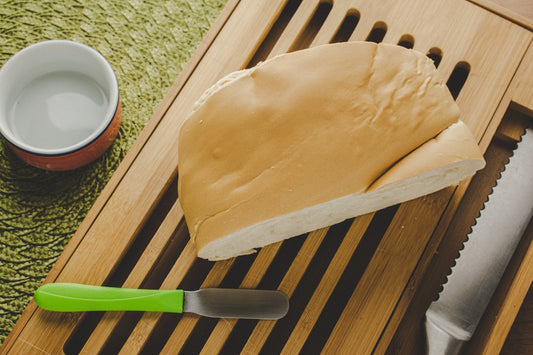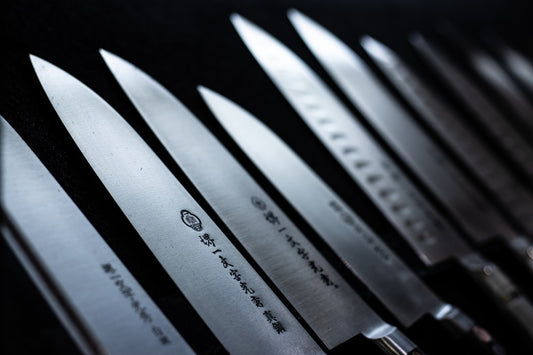
Share
Nakiri vs Western Vegetable Knife: A Detailed Guide to Japanese and Western Knife Styles
Estimated reading time: 12 minutes
Key Takeaways
- The Nakiri knife is a specialized Japanese vegetable knife with a straight, rectangular blade.
- Western vegetable knives are versatile, with curved blades suitable for rocking motions.
- Japanese knives often use harder steel and thinner blades for precision, while Western knives focus on durability.
- Choosing between Nakiri and Western knives depends on your cooking style and needs.
Table of Contents
- The Nakiri Knife: A Vegetable Specialist
- Understanding the Western Vegetable Knife
- Nakiri vs Western Vegetable Knife: Side-by-Side Comparison
- Gyuto Knife Review – The Japanese Chef’s Knife
- Santoku Knife Advantages – Compact Power for Slicing, Dicing, and Mincing
- How to Choose a Petty Knife
- Sujihiki vs Carving Knife – Slicing Like a Professional
- Deba vs Boning Knife – Heavy Duty Filleting and Butchery
- Conclusion: Finding the Right Knife for Your Kitchen
- Additional Resources for Japanese Knife Skills and Maintenance
The Nakiri Knife: A Vegetable Specialist
What Is a Nakiri Knife?
A Nakiri knife is a classic Japanese vegetable knife. Its most recognizable feature is a straight, rectangular blade with a flat edge. This shape stands out from the curved lines of Western knives. The full-contact, flat edge means you can cut all the way through vegetables without needing to rock the blade—just a straight push down to the board.
Key Nakiri Features:
- Straight-edge, rectangular blade for full-contact cuts
- Double-beveled (sharpened on both sides) for easy straight chopping
- Ideal for precise, straight push-cutting of vegetables
- Produces thin, uniform slices and minimizes cell damage to delicate produce
In Japanese cuisine, the Nakiri knife is used for everything from chiffonading greens to precise dicing for decorative plating. It’s especially valued when you want ingredients to look their best and maintain their crisp texture.
Find out more about What is a Nakiri Knife?
Benefits of the Nakiri Knife
- Exceptional vegetable performance: Slices, dices, and chops even delicate vegetables cleanly and easily
- Preserves ingredient quality: Minimal bruising or crushing thanks to the incredibly sharp, thin edge
- Perfect for presentation: Uniform cuts enhance both the look and texture of dishes
- Quick, efficient prep: The straight edge enables rapid push cutting
Limitations of the Nakiri Knife
Even though the Nakiri knife shines for vegetable prep, it does have limits:
- Narrow specialization: Not as versatile as some Western knives—best for vegetables only
- Not for heavy-duty: Not suitable if you need to cut through meats, bones, or hard root vegetables
- Requires careful maintenance: Thinner, harder steel can chip with rough use
For cooks who focus on produce and want perfect results, the Nakiri is essential. But if you need versatile all-rounders, it pays to look beyond this classic Japanese vegetable knife.
Explore more background on this from Oishya’s guide.
Understanding the Western Vegetable Knife
Anatomy of the Western Vegetable Knife
A Western vegetable knife—often a chef’s knife or utility vegetable knife—has some distinct differences from the Nakiri. Most noticeably, its blade is curved (sometimes called the "belly"), and it ends in a pointed tip. Designed for a rocking motion, Western knives are usually heavier and thicker, and are commonly made with softer steels compared to Japanese cutlery.
Key Western Vegetable Knife Features:
- Curved "belly" allows for smooth rocking cuts
- Thicker, heavier blade for more resilient tasks
- Softer steel is easier to sharpen and maintain
- Pointed tip provides versatility in many kitchen tasks
This type of knife is a staple in Western kitchens due to how it balances slicing, dicing, mincing, and even some light butchery.
Learn more about these differences at Chubo Knives.
Nakiri vs Western Vegetable Knife: Side-by-Side Comparison
The debate of Nakiri vs Western vegetable knife is best understood by breaking down their core features and advantages in daily kitchen use.
Blade Geometry & Design
Nakiri:
- Straight, flat edge
- Rectangular, tall profile
Western Vegetable Knife:
- Curved "belly" for rocking motion
- Pointed tip with a standard height
Cutting Techniques
Nakiri:
- Specialized for push-cutting and chopping
- Efficient for up-and-down straight cuts (no rocking needed)
Western Vegetable Knife:
- Designed for rocking and slicing, with flexibility for different styles
- Handles chopping, mincing, and slicing with ease via the blade curve
Steel Hardness & Maintenance
Nakiri:
- Made with harder, high-carbon steels
- Holds a sharp edge longer, but needs careful, gentle sharpening and maintenance
Western Vegetable Knife:
- Softer steel resists chipping but dulls faster
- Sharpened more frequently but with less risk for beginners
Cutting Style & Results
Nakiri:
- Excels at delicate, precise cuts
- Minimal cell damage, important for presentation and texture
Western Vegetable Knife:
- More forgiving, can handle tough ingredients or rush jobs
- Slightly rougher on delicate produce
Kitchen Task Suitability
Nakiri knife: Top choice for specialized vegetable work, fine presentation, sushi, salads.
Western vegetable knife: Best for all-purpose cooks—works with vegetables, proteins, and more.
Comparative Table: Nakiri vs Western Vegetable Knife
| Feature | Nakiri | Western Vegetable Knife |
|---|---|---|
| Blade Geometry | Straight, flat edge; rectangular | Curved belly; pointed tip |
| Typical Use | Push cutting, chopping vegetables | Rocking motion, general use |
| Steel Hardness | Harder steel, thinner blade | Softer steel, thicker blade |
| Cutting Style | Precision, clean straight cuts | Robust, versatile |
| Main Advantage | Uniform slices, delicate prep | All-purpose, forgiving of hard tasks |
Summary: Choose a Nakiri for superior vegetable prep and fine slicing. Opt for a Western vegetable knife when you need one blade to do it all.
Explore more background on this from Oishya’s guide.
Gyuto Knife Review – The Japanese Chef’s Knife
What Is a Gyuto Knife?
The Gyuto knife is the Japanese take on the classic chef’s knife, designed for all-purpose kitchen use. It stands out with a thinner, lighter blade and often sharper edge compared to Western chef’s knives. Its edge is gently curved, supporting both push/pull and rocking cuts.
Gyuto Knife Review:
- Thinner, lighter blade for less fatigue and more agility
- Great for slicing meat, mincing garlic, and chopping vegetables
- Accommodates both Japanese (push/pull) and Western (rocking) cutting styles
- Stays sharper longer due to higher-grade steel
See more on Gyuto knife advantages from Chubo Knives.
Santoku Knife Advantages – Compact Power for Slicing, Dicing, and Mincing
Santoku Knife Features
Santoku knives, meaning “three virtues,” are made for proficiency with slicing, dicing, and mincing. They’re typically shorter and a little taller than the Gyuto, and have a flatter edge with a fast curve at the tip.
Santoku Knife Advantages:
- Compact length: 16–18 cm (compared to the Gyuto’s 20–24 cm)
- Maneuverable shape: Easy to control, especially in tight spaces or small kitchens
- Flat edge: Great for up-and-down slicing, makes for straight, even cuts
- User-friendly: Easy to learn for beginners; comfortable grip
- Granton edge: Some Santoku knives have scalloped dimples to keep food from sticking
Read more in Oishya’s Santoku overview.
How to Choose a Petty Knife
What Is a Petty Knife?
A petty knife is the Japanese answer to the utility or paring knife. Small and nimble, it’s built for peeling, trimming, and other fine-detail tasks too delicate for large knives.
Key Petty Knife Features:
- Blade length usually between 90 mm and 150 mm
- Lightweight for quick, controlled movements
- Excellent for working with small fruits, vegetables, and proteins
For more details, see Oishya’s advice on petty knives.
Sujihiki vs Carving Knife – Slicing Like a Professional
The Sujihiki Knife Explained
The Sujihiki knife is Japan’s answer to the slicer—a slender, long blade designed for cleanly slicing boneless proteins with grace. It’s double-beveled and made from hard steel, allowing ultra-smooth, paper-thin cuts, whether for raw fish or cooked meats.
Explore more in Sujihiki vs Carving Knife – Slicing Like a Professional.
Deba vs Boning Knife – Heavy Duty Filleting and Butchery
The Deba Knife: Fish Specialist
A Deba knife is a powerful Japanese blade, made for filleting and breaking down whole fish. Its thick spine and solid weight give enough power to cut through fish bones and heads, while the blade remains razor-sharp and typically single-beveled.
Find more info at Hasu Seizo’s comparison.
Conclusion: Finding the Right Knife for Your Kitchen
Japanese knives, from Nakiri to Yanagiba, showcase the highest standards of craftsmanship and specialization—each style conceived for perfect execution of distinct culinary tasks. By contrast, Western knives embrace the philosophy of versatility and ruggedness, providing reliable performance across many kitchen jobs.
When considering Nakiri vs Western vegetable knife or any of the Japanese knives listed above, think about:
- Your typical cooking style (lots of vegetables? sushi? hearty roasts?)
- Primary ingredients you prepare
- Your skill and comfort with knife maintenance (Japanese blades need extra care!)
Practical Steps for Choosing:
- Try before you buy: Visit a store or take a cooking class to handle different blade styles
- Start with essentials: Invest in one all-purpose blade (Gyuto or Santoku) plus one specialty knife (Nakiri or Petty)
- Maintain your knives: Buy a proper whetstone and learn Japanese sharpening techniques
- Expand as needed: Add specialty blades like Sujihiki, Deba, or Kiritsuke as your skills and interests grow
Additional Resources for Japanese Knife Skills and Maintenance
To master your knives and enjoy peak performance, ongoing learning makes all the difference. Explore:
- YouTube Channels: Professional knife smiths and chefs share sharpening, cutting, and maintenance tips in free tutorial videos
- Retailer Guides: Trusted sellers provide maintenance, sharpening, and care instructions
- Culinary Schools and Cooking Stores: Hands-on classes in knife skills and Japanese blade care
Recommended Search Terms:
- Japanese knife skills
- Japanese knife maintenance
- Knife skills tutorial Gyuto/Nakiri/Santoku
- Sharpening Japanese knives with a whetstone
- Kiritsuke vs Yanagiba demonstration
FAQ
What is the main difference between a Nakiri and a Western vegetable knife?
The main difference lies in the blade design and cutting technique. A Nakiri has a straight, flat edge ideal for push-cutting vegetables, while a Western vegetable knife has a curved blade suitable for rocking motions and general-purpose use.
Can I use a Nakiri knife for meat?
Nakiri knives are specialized for vegetable work and are not designed for cutting meat, bones, or hard root vegetables. Using it for these tasks may damage the blade.
Which knife should a beginner choose?
Beginners may find a Santoku knife or a Western chef’s knife more versatile and user-friendly, as they handle a variety of tasks and are easier to maintain than specialized knives like the Nakiri.
How do I maintain a Japanese knife?
Maintain your Japanese knife by hand-washing it with mild soap, drying it immediately, and sharpening it regularly using a whetstone. Avoid cutting hard materials to prevent chipping.
```


